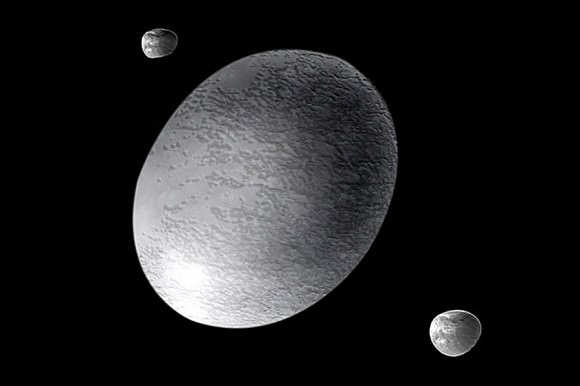A unique opportunity to study the dwarf planet Haumea has led to an intriguing discovery: Haumea is surrounded by a ring.
Add this to the already long list of unique things about the weird-shaped world with a dizzying rotation and a controversial discovery.
On January 21, 2017 Haumea passed in front of a distant star, in an event known as an occultation. The background star can – pardon the pun – shine a light on the object passing in front, providing information such as the size, shape, and density of objects that is otherwise difficult to obtain. Since an occultation with Haumea had never been observed before, scientists were first eager, and then surprised.
"One of the most interesting and unexpected findings was the discovery of a ring around Haumea," said says Pablo Santos-Sanz, from the Institute of Astrophysics of Andalusia (IAA-CSIC) in a statement.
This is the first time a ring has been discovered around a trans-neptunian object, and the team said this discovery shows that the presence of rings could be much more common than was previously thought, in our Solar System as well as in other planetary systems.
"Twelve telescopes from ten different European observatories converged on the phenomenon," said José Luis Ortiz, who led the observational effort, and is also from IAA-CSIC. "This deployment of technical means allowed us to reconstruct with a very high precision the shape and size of dwarf planet Haumea, and discover to our surprise that it is considerably bigger and less reflecting than was previously believed. It is also much less dense than previously thought, which answered questions that had been pending about the object."
The team said their data shows that the egg-shaped Haumea measures 2,320 kilometers in its largest axis. Previous estimates from various observations put the size at roughly 1,400 km. It takes 3.9 hours for Haumea rotate around its axis, much less than any other body in the Solar System that measures more than a hundred kilometers long. This rotational speed likely caused Haumea to flatten out, giving it an ellipsoid shape. It orbits the Sun in an elliptical orbit that takes 284 years to go complete. Additionally Haumea has two small moons.

Artist's impression of the dwarf planet Haumea and its moons, Hi'aka and Namaka. Credit: NASA
Ortiz and team say their data shows the newly discovered ring lies on the equatorial plane of the dwarf planet, and it "displays a 3:1 resonance with respect to the rotation of Haumea, which means that the frozen particles which compose the ring rotate three times slower around the planet than it rotates around its own axis."
Ortiz says there might be a few possible explanations for the formation of the ring; it may have originated in a collision with another object, or in the dispersal of surface material due to the planet's high rotational speed.
Of course, other objects in our Solar System have rings: all the giant planets have rings, with Saturn's being the most massive and well know. But small centaur asteroids located between Jupiter and Neptune were found to have rings, too.
"Now we have discovered that bodies even farther away than the centaurs, bigger and with very different general characteristics, can also have rings," said Santos-Sanz.
You may recall there was great controversy over the discovery of Haumea. The discovery was originally announced in 2005 by Mike Brown and his team from Caltech, but then Ortiz and Santos-Sanz attempted to scoop Brown et. al by sending in their claim to discovery to the Minor Planet Center before Brown's paper was published. It was later learned that Ortiz and colleagues had accessed the Caltech observing logs remotely, looking at when and where Brown was looking with his telescopes. They initially denied the claims, but later conceded accessing the observation logs, maintaining they were just verifying whether they had discovered a new object in observations from 2003.
I asked Brown today if anything was ever officially resolved about the controversy.
"I think the resolution is that it is generally accepted that they stole our positions, but no one wants to think about it anymore," he said via email.
But the discovery of a ring Haumea, Brown said, looks solid.
"I will admit to being wary of anything Ortiz says, so I checked the data very carefully," Brown said. "Even I have to agree that the detection looks pretty solid. Haumea is weird, so it's less surprising than, say, finding rings around something like Makemake. But, still, this was not something I was expecting!"
Sources: IAA-CSAC, email exchange with Brown.
No comments:
Post a Comment